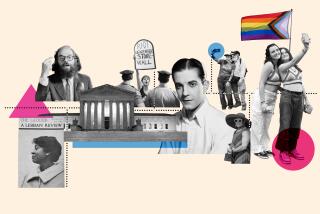Patient Zero, and AIDS, enter the history books
- Share via
I MET MICHAEL, the man who became my Patient Zero, in early 1981. I was 33 years old; he was 31. He was rail thin with short, bleached-blond hair and high cheekbones. I remember him in more detail than patients I saw yesterday.
Michael had been admitted through the UCLA emergency room days earlier complaining of fever and weight loss. Quickly, a rare type of lung infection called pneumocystis blossomed on his chest X-ray.
My immediate suspicion was that he was immune deficient. Although rare, pneumocystis was known to occur in immunologic disorders. Using what was then considered new technology to test his blood, we discovered that critical cells, called “T cells,” were missing.
In the weeks that followed, two more men were referred to us with virtually identical symptoms. Like Michael, each said he had always been healthy and had no past history of difficulty fighting infections, suggesting that the immune deficiency was acquired. Like Michael, each told me that he was gay. In those days, our subcultures -- white-coated medics and gay men -- were worlds apart. But that was about to change.
Then two more cases came in. At that point, my colleagues and I felt the information had to be made public. On June 5, 1981 -- 25 years ago today -- I published the details of Michael’s case and four others in the Morbidity and Mortality Weekly Report put out by the Centers for Disease Control and Prevention. It was the first description of a new disease, a date that later became known as the official onset of the HIV/AIDS epidemic.
“All the above observations suggest the possibility of a cellular-immune dysfunction related to a common exposure that predisposes individuals to opportunistic infections,” I wrote in that initial report. I added that the fact that all the patients were gay suggested “an association between some aspect of a homosexual lifestyle or disease acquired through sexual contact.”
Michael and my other early patients died within that first year. Within days of the June 5 report, doctors began telephoning from all over the nation to tell me about their own patients with pneumocystis. Over time, intensive care units at UCLA and across the country began to fill with young gay men requiring ventilators, their lungs choked with the same strange organism. The AIDS epidemic was underway.
It is still astonishing to me that a disease that spread from chimpanzees to humans in Central Africa probably as early as the 1930s was first detected in West Los Angeles in 1981. In retrospect, we know that HIV had traveled to U.S. shores as early as 1977. And the earliest known positive HIV blood sample is from 1959, obtained from an unknown man in Kinshasa, Congo, and frozen.
Since my first report to the CDC, more than 500,000 people have died of AIDS in the United States. Globally, 25 million people have died of the disease, which is now the leading cause of death worldwide among those between the ages of 15 and 59.
As a doctor working on the epidemic’s front lines since its inception, I find this anniversary one of intense emotions: despair about the lives lost to the disease; frustration with the Bush administration’s promotion of abstinence over condoms for HIV prevention; anger at the denial, stigma and prejudice that still fuel the spread of HIV around the globe. But mixed in with those feelings is also pride in the remarkable medical progress we’ve made in HIV treatment. Twenty-five years ago, AIDS meant certain death. Even when my patient Rock Hudson was diagnosed with AIDS in 1985, the best I could do was recommend an experimental -- and ultimately ineffective -- treatment.
It wasn’t until the advent of the AIDS “cocktail” 15 years into the epidemic that we began to turn this disease around. Those new treatments were truly revolutionary: Almost overnight, people with HIV left hospital beds and were back at work and living their lives. In one year, the number of Americans who died from AIDS dropped by 43%, and over the last decade, the death rate fell more than 70%.
For the first time, we as physicians could even use antiviral medicines to prevent the transmission of HIV from an HIV-infected mother to her newborn child. Symbolic of our progress is that very soon we will have a single, once-daily pill containing a complete “AIDS cocktail” for the disease that 25 years ago was a death sentence.
I believe overcoming AIDS means extending our medical progress to everyone -- and that’s a tall order. HIV is spreading disproportionately among African Americans and Latinos, and those infected are still less likely than their white counterparts to get the care they need. Worldwide, 5 million people with HIV in developing countries need medicine urgently.
Thanks to initiatives by the United Nations, the U.S. and others, 1.3 million people began therapy over the last five years, and an estimated 350,000 deaths were averted in 2005 alone. But 40 million men, women and children are still living with HIV. Nobody should die from AIDS (or for that matter malaria or TB) because of where they live or their economic status.
Will there be a 50th anniversary of AIDS? Since I saw those first unfortunate patients 25 years ago, medical science has worked miracles. But the end of AIDS is not yet in sight. Minimizing the impact of another quarter-century of this plague hinges on our collective will to prevent new infections, find a vaccine and cure and get lifesaving medicines to all who need them.






